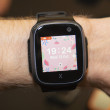Review: HTC Desire 626 for AT&T
Aug 18, 2015, 3:45 PM by Eric M. Zeman
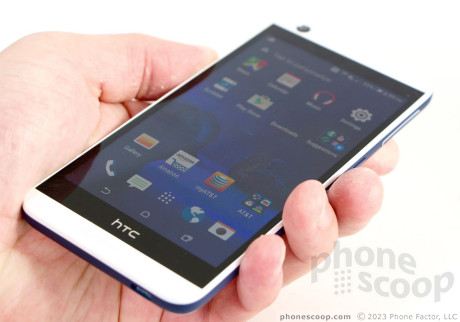
This mid-range handset from HTC borrows from the company's high-end designs and repackages them in a more affordable piece of hardware. With Android and Sense aboard, owners have plenty of options to make the Desire 626 their own. Here is Phone Scoop's full report.
Hardware
Is It Your Type?
The HTC Desire 626 is for those who fancy HTC's hardware and software designs, but don't necessarily want or need a flagship-class smartphone.
Body
The Desire 626 borrows its design heavily from two older phones, the Desire Eye and the Desire 610, both of which are still sold by AT&T. The 626 is a polycarbonate handset that has solid front and back hues separated by a colorful, wrap-around band. I like the juxtaposition of colors, but each carrier gets its own combination and AT&T picked the boring white with blue variant.
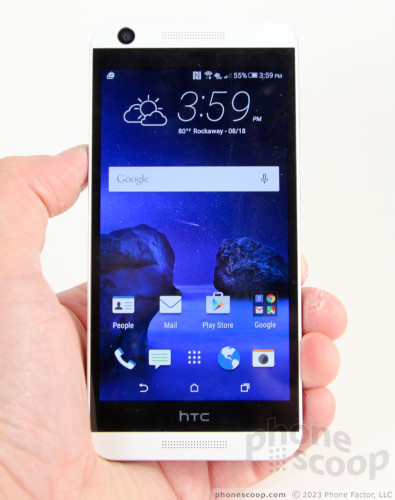
The 626 is an HTC handset through and through; it includes all the major HTC characteristics. It has matching speaker grilles above and below the screen, simple lines, and good build quality. It's about the same size as the HTC One M9. The rounded side edges are appealing and do a lot for comfort. The matte finish to the materials is nice to the touch. I appreciate that the 626 isn't over-designed; it's simple and classy.
Thanks to the 5-inch screen, the 626 is generally easy to use one-handed. I've seen more compact 5-inch handsets, but the 626 isn't overly large. I was able to reach most of the screen with my thumb and had no problem gripping the phone in my hand thanks to the narrow width. The weight of the phone is right where it should be; it's not too heavy, nor is it too light (yes, there is such a thing!) The 626 should fit into most pockets without issue.
HTC picked decent materials for the phone and the pieces all appear to be assembled tightly, with smooth joints. The 626 doesn't have the same obvious strength that metal-clad HTC One series has, but it still feels strong enough.
The front panel is formed by two elements: a polycarbonate frame and the glass for the display. The bezels around the screen itself could be thinner, but that's typical for an HTC handset. HTC set the glass just below the plastic frame, which forms a small lip around the edge of the screen, to protect the glass. The speakers provide nice balance to the front of the phone. The user-facing camera module is large and easily spotted from quite a distance. You'll find no front buttons, as the 626 relies on software controls.
HTC tucked the controls, buttons, and hatches into the 626's side edges in a tasteful way. A single, large hatch is positioned on the left side of the phone. Pry it open and you'll find the SIM and memory card slots. The SIM card slot has a removable tray to help hold the SIM card in place. The tray is made of plastic and is rather flimsy. The hatch is easy to operate and closes up seamlessly.
The remaining controls follow a familiar pattern. HTC stuck the screen lock button and volume toggle on the right edge of the phone. The screen lock button has a low profile and rather weak travel and feedback. I'd prefer if this button stood out more both visually and physically. The volume toggle has a nice white accent surrounding it, which makes it pop, and it's much better than the screen lock key. The headphone jack is up top and the USB port is on the bottom.
I like how stable the phone is when placed on a flat surface, especially when it comes to text entry. The rear panel cannot be removed. In fact, AT&T/HTC placed a huge sticker on the back warning owners that the rear panel can not and should not be pulled off. That means no swapping batteries, which is sure to annoy some people. The camera module is highlighted by a nice blue accent.
The 626 is a good-looking smartphone, considering its price point. It compares well to AT&T stablemates such as the Microsoft Lumia 640, the LG G Vigor, and Motorola Moto G (2nd Gen).
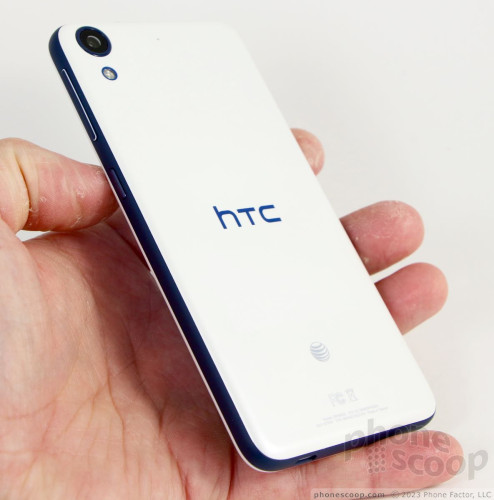
Screen
HTC sticks to LCD screens, and that's generally a good thing. The Desire 626 has a 5-inch touch display with 720p HD resolution. The size and resolution combination work well for the most part. I didn't see any obvious pixels anywhere, and text/images have smooth edges throughout. Color is accurate and viewing angles are good; I didn't see any color shift when the phone was tilted, but brightness decreases just a bit. I found brightness to be acceptable most of the time, but you do have to crank the screen all the way up when you're outside. This shouldn't be a problem if you make use of the auto-brightness function.
Signal
I found that the 626 mostly performed on par with other phones I've tested on AT&T's network in the greater NYC region. The phone remained connected to AT&T's LTE 4G network the majority of the time I used it, with sporadic drops down to HSPA in areas with poor coverage. The 626 never dropped the network completely. I was able to make and receive calls without issue; the phone never dropped or missed any calls.
Data performance was good but not great. Speeds for simple browsing were solid enough, but I was disappointed by laggy load times for Facebook and Instagram. Downloading apps over LTE 4G could have been faster, too.
Sound
Call quality is just fine. Voices came through the earpiece speaker loud and clear. I tended to keep the volume set most of the way up to make sure I could hear calls in any environment, but you can dial it back if you're in a quiet space. Clarity was pleasant, with no breakup or distortion in the speaker. Voices could have been a tad warmer, but I have no real complaints. Those I spoke to said I sounded good.
The speakerphone is positioned in the lower of the two speaker grilles on the front of the 626. This means the speakerphone is effective whether you place it on a flat, hard surface or not. Voices were mostly loud enough via the speakerphone, and clarity only suffered from mild distortion. I wish the speakerphone were a bit louder, but you should still be able to understand calls when in a moving car or other moderately noisy space.
Ringers and alerts can be set to bone-jarring volumes. The 626 can wake the dead. The vibrate alert is just OK.
The Desire 626 may look like it has HTC's BoomSound stereo speakers, but I assure you it does not. The single loudspeaker at the bottom was not designed for high-quality music playback. It produces lots of volume if you want to listen to tunes, but I'd recommend against it. The quality just isn't there. The FM radio functions only when you plug in headphones. The stand-alone music app lets you shape sound a little bit to suit your tastes.
Battery
HTC gave the Desire 626 a 2,000 mAh battery, which is a bit small as far as I am concerned. On the average day, the phone barely made it from breakfast to bedtime. It conked out on me around 10pm a couple of times. When used heavily, the phone was gasping by 8 or 9pm. That's not good enough in my book.
The phone does have two battery saver tools on board, HTC's Power Saver mode and Extreme Power Saver mode. The first dials things back a bit and can extend battery life modestly. The second is more aggressive and can add hours to the battery as long as you don't mind limited functionality.
Bluetooth, GPS, NFC, WiFi
I tested Bluetooth via my car's hands-free system and the 626 did all right. I was able to make some calls and understand them when moving at highway speeds. Quality and volume were just good enough. I was disappointed with the 626's music playback through my favorite Bluetooth speaker. Without the aptX profile on board, the stereo Bluetooth only goes so far. The phone didn't have any trouble connected to other Bluetooth devices, such as wearables or PCs.
The GPS, NFC, and WiFi radios functioned without issue. The 626 located me accurately, but not quickly. NFC worked perfectly for easy pairing with other Bluetooth devices; and WiFi delivered a faster mobile browsing experience than LTE.
Software
Lock Screen
HTC's lock screen hasn't changed much over the years and it still offers several basic features.
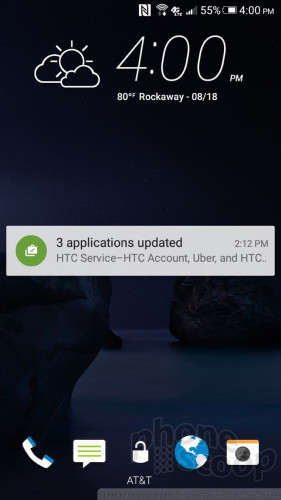
Users can select from five different lock screen behaviors, depending on how you care to secure the handset. The simplest offers no lockscreen at all; pressing the screen lock button takes you straight to the home screen. The second displays the lock screen, but doesn't require a password. The other three options each require a different type of password (PIN, pattern, alpha-numeric password). All but the first show the clock, notifications, and shortcuts.
I wish you could control the appearance of the clock, but you cannot. The lock screen itself doesn't do anything unique or special to showcase notifications; instead, you'll need to tweak notifications at the OS level to prevent that most recent phone call or text message from spilling your dirty secrets. The lock screen supports up to five shortcuts, which you can customize at will.
Home Screens
The Desire 626 runs Android 5.1 Lollipop with the newest rendition of HTC Sense on top. Sense is one of the heavier-handed user interface skins. Sense has its own fonts, icons, graphics, and settings tools. It is relatively easy to get a handle on, and offers a rich set of personalization features.
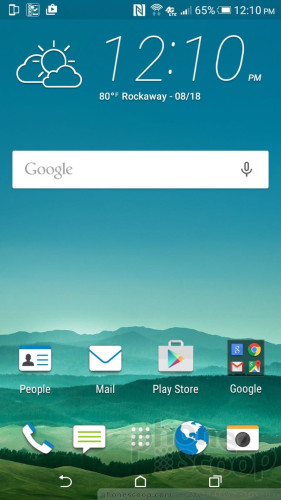
The home screen panels and notification shade work pretty much the same as they do on all Android handsets. HTC's app menu offers a lot more flexibility than the stock Android version, as it allows users to arrange apps alphabetically, in a custom arrangement, or via most-recently-used. It also lets people change the size of the grid, as well as hide and otherwise manage apps.
HTC included its BlinkFeed social news reader app, which is, by default, the left-most homescreen panel. You can disable it if you want.
Customizing the home screen appearance is a key trait of Sense, and that's no different on the Desire 626. Users can change the navigation buttons, select from 9 preinstalled themes, and then tweak each theme with various accent colors, wallpapers, keyboards, fonts/sizes, and on and on.
Performance is my greatest worry with the Desire 626. The phone is kneecapped by a 1.1GHz Snapdragon 210 processor. I found it often wasn't up to the task of keeping the Desire 626 running smoothly. Apps were slow to load, screens were laggy in transition, multitasking was an exercise in frustration. The phone slogged through app installs and updates. It's borderline, my friends.
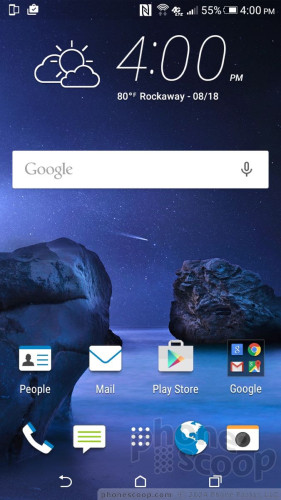
Camera
The Desire 626's camera app is almost a direct carryover from the One M9's camera app, minus some of the best features. You can open the app from the lock screen, but there is no dedicated camera button.
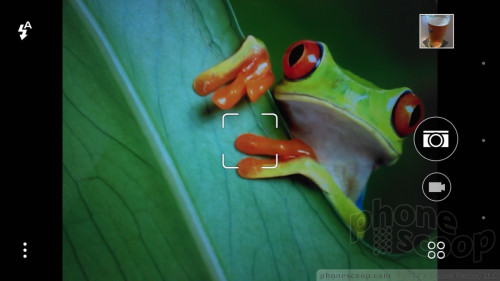
The basic viewfinder includes separate shutter buttons for the camera and video camera, a button to switch between the different shooting modes, and access to the gallery. The camera also has a flash toggle and an in-depth menu/settings tool.
The 626 ships with three main shooting modes: normal, selfie, and panorama. These are self-explanatory. In addition to the dedicated camera mode switcher, you can jump between the modes quickly by swiping your finger up or down on the screen, similar to the One M9. Unlike the One M9, however, you cannot download and install other shooting modes, nor can you create your own custom modes. That's a bit of a bummer.
The settings offer a reasonable degree of control over the camera's behaviors, such as ISO, exposure, and white balance. You may also select from several different scenes, such as night, HDR, portrait, landscape, and macro. The deep-down options menu lets you set aspect ratio, "make-up level" (software-controlled beautification), review duration, sounds, etc.
The camera app isn't too fussy or complicated, and offers a nice balance of features. You can just as easily enjoy point-and-shoot behavior as you can more fine-tuned creativity. It's up to you. The camera is relatively quick to open and shoot photos.
Photos/Video
The Desire 626's main sensor captures 8 megapixels. I'd call the photos average. Some had sharp focus, good white balance, but weird exposure, while others had soft focus, odd colors, and perfect exposure, and so on and so forth. Rarely were all three qualities spot on. Grain was present in every low-light image I took, flash or not. I'd trust the 626 with everyday snapping needs, but not for anything important.
The selfie cam can snag 5-megapixel images. They were mostly a grain-filled mess, with some random acceptable exposures tossed into the mix.
I was more pleased with the ability of the 626 to capture reasonably good video. It maxes out at 720p HD, but it does well enough with exposure, color, and focus to make up for the lack of pixels. I wouldn't use it to record a relative's wedding, but might rely on it to capture some ducks swimming at the local park.
HTC/AT&T Stuff
AT&T continues to load its handsets with excrement. The Desire 626 has no fewer than 17 AT&T-branded apps pre-installed, which doesn't include third-party junk like Amazon or Lookout.
HTC's most interesting apps are the Zoe app and the related One Gallery app for making creative images and storing/sharing them online.
Wrap-Up
The HTC Desire 626 is a middle-of-the-road handset. I don't dislike it, but it doesn't offer any compelling features that aren't also available on competing phones
The hardware's design is pleasant enough and assembled well. The screen is decent and wireless performance is all right, but I was a bit disappointed by battery life and the processor's performance. HTC's treatment of Android may offer lots of flexibility, but it comes at the cost of an over-wrought design. I wish the camera application had a few more features, but it should suffice for most people.
I'd recommend the HTC Desire 626 to true fans of HTC's handsets who are on a budget. It's not a bad value, but other phones available from AT&T — like the Motorola Moto G — are better.

Comments
No messages


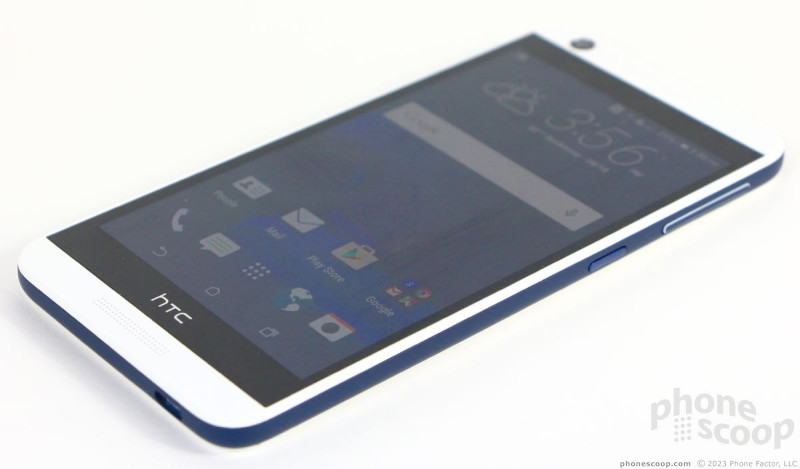















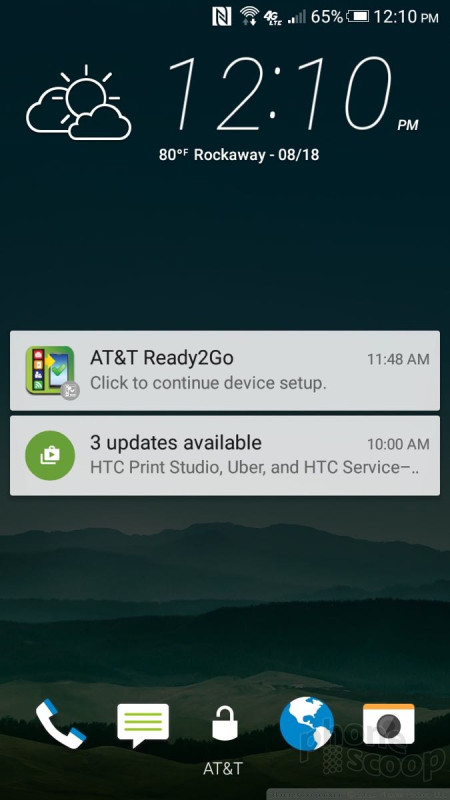




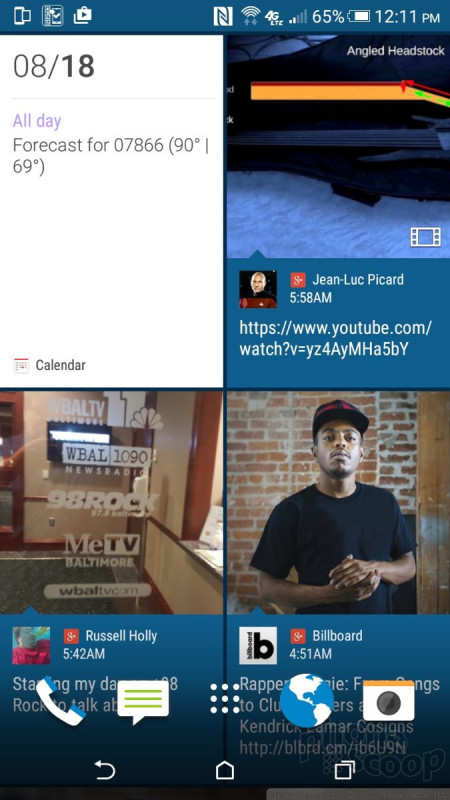







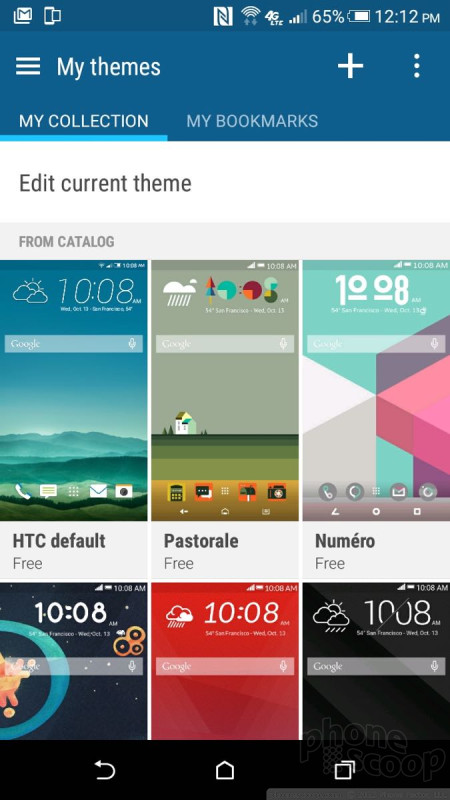



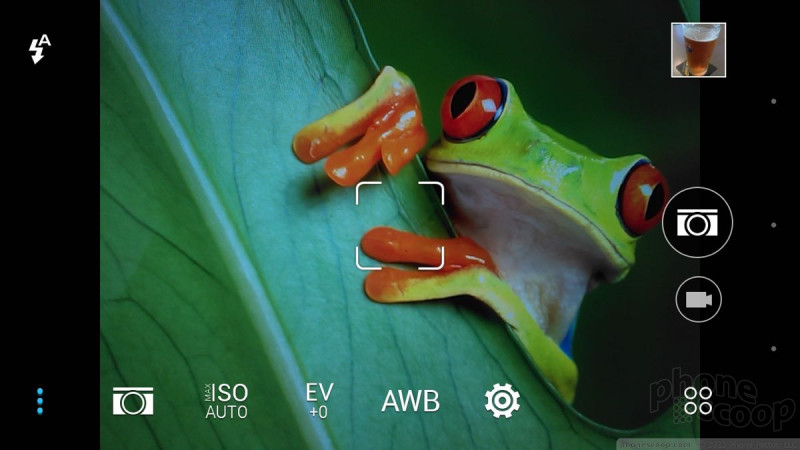





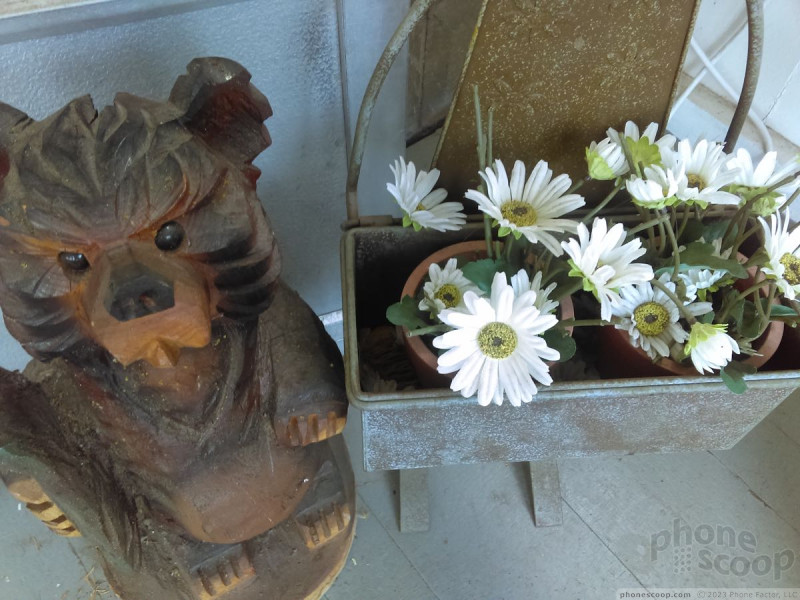













 Samsung Refreshes Galaxy S Series with S Pen, New Cameras
Samsung Refreshes Galaxy S Series with S Pen, New Cameras
 iPhone 14 Plus Offers a Big Screen For Less
iPhone 14 Plus Offers a Big Screen For Less
 HTC Desire 626 (GSM)
HTC Desire 626 (GSM)



